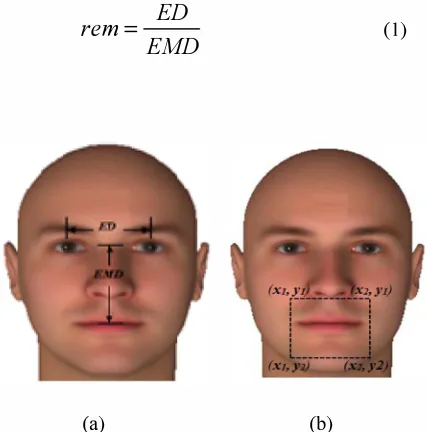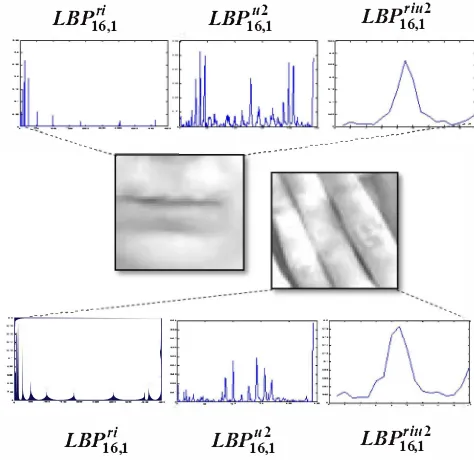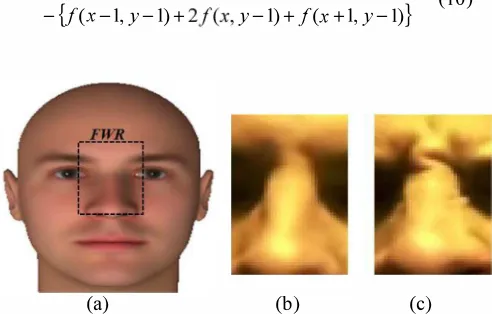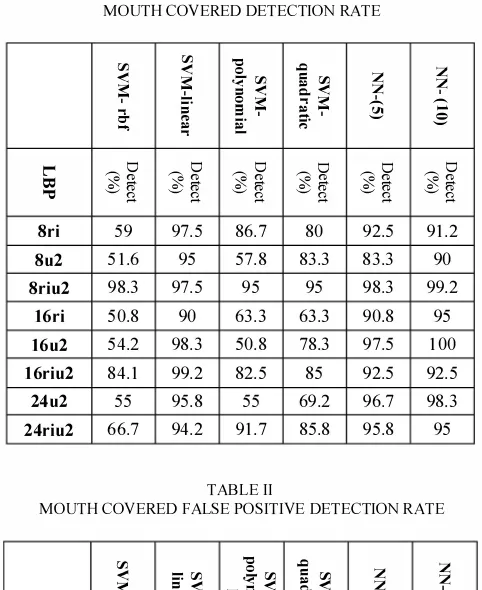Mouth Covered Detection For Yawn
Masrullizam Mat Ibrahim *1, John S Soroghan *2, Lykourgos Petropoulakis *3
*Centre for Excellence in Signal and Image Processing (CeSIP) Electronic and Electrical Engineering Department, Universiy of Strathclyde
204
George Street, Glasgow GI I, Scotlan, United Kingdom.1 masrullizam.bin-mat-ibrahim@strath.ac.uk 2 j.soraghan@strath.ac.uk
3 1. petropoulakis@strath.ac. uk
Abstract- Yawn is one of the common fatigue sign phenomena. The common technique to detect yawn is based upon the measurement of mouth opening. However, the spontaneous human action to cover the mouth during yawn can prevent such measurements. This paper presents a new technique to detect the covered mouth by employing the Local Binary Pattern (LBP) features. Subsequently, the facial distortions during the yawn process are identiied by measuring the changes of wrinkles using Sobel edges detector. In this research the Strathclyde Facial Fatigue (SFF) database that contains genuine fatigue signs is used for training, testing and evaluation of the developed algorithms. This database was created from sleep deprivation experiments that involved twenty participants.
Kywords-Yawn, fatigue, mouth covered, destotion detection, database.
I. INTRODUCTION
Fatigue is a syndrome that is well known as tiredness, exhaustion or lethargy, and it is a common health complaint. Generally, fatigue is deined as a feeling of lack of energy and can be caused by inadequate rest, long hours of physical and mental activity, sleep disturbance, excessive stress or a combination of these factors. The symptoms of fatigue can be felt as well as having annoying effects such as impairment of hand-eye coordmation, low motivation, poor concentration, slow relexes and response, feeling overwhelmed and inability to pay attention. The fatigue causes have contributed the largest number of road accidents, leading to loss of drivers' and passengers lives. According to the UK Department of Transport[I], in 2010, 1850 people were killed, and 22,660 were seriously injured. Furthermore, fatigued drivers have contributed to a 20% of total road accidents [2]. In USA, the administration of National Highway Traic Safety estimates that there are approximately 100,000 crashes each year caused by fatigue and drowsiness [3].
In general the fatigue detection can be recognised rom physiological activities such as eye and mouth activities, brain activities, and heart activities. Furthermore, the physical activities and behavior of human also can indicate the sign of fatigue such as implemented in [4-6]. Yawn is a symptom that visually indicated by widely mouth opening.
Because of this, all researches in yawn detection research focus on the technique to measure and classiy the mouth openmg [7-10]. In this paper, we introduce a new approach to detect the mouth covered with the distortion detection. For the mouth covered detection the LBP features and leaning machine classiier are employed. In order to detect the distortion of speciic face region the Sobel operator of edges detector is used. In this research, the genuine yawn signs of fatigue rom Starathclyde Facial Fatigue (SFF) database are utilised for the training, testing and evaluation. This video footage database is developed explicitly to acquire signs of fatigue rom the faces of subjects in various stages of sleep deprivation. The ethically approved sleep deprivation experiments were conducted at the University of Strathclyde. Twenty participants were involved in these experiments each one was sleep deprived for periods of 0, 3, 5 and 8 hours on separate occasions. During each experimental session the participants' faces were recorded while carrying out a series of cognitive tasks.
II. REGION INTEREST INITILISATION
A. Focused Mouth Region (FMR)
The focused mouth region (FMR) is formed based on the irst detected location of the eyes and mouth. The distances of these two main face components are measured. A distance between the centre of eyes ED, and a distance between centre of mouth and the middle point between eyes
EMD as shown in Fig.l (a) are obtained. Then, the ratio of this distance rem is computed as follows:
ED
rem=
--EMD (1)
(a) (b)
Fig.l. (a) Anthropometric measurement. (b) Focus Mouth Region (FMR)
From these two distances the coordinate of the FMR as shown in Fig.l(b) are empirically deined as follows:
(2)
[X2] [ X. ]
Y2 - YL + O.75EMD + O.8ED (3)
The FMR is dependent on the location and distance of the eyes, when the face moves forward the eye distance increases and so does the FMR. On the other hand, the FMR becomes smaller when the face moves backwards.
B. Focus Distortion Region (FDR)
The focused distortion region (FDR) is a region in the face that is used to measure changes of facial distortion. This region, which is most likely to undergo changes (i.e. facial distortions) during yawn, was identiied based on conducted experiments using the SFF database. The
coordinates of FDR, shown in 2(b), are empirically deined as:
(a) (b)
Fig. 2. (a) Anthropometric measurement, (b) Focused Distortion Region (FDR)
III. COVERED MOUTH DETECTION
(4)
(5)
It is not unusual to hand-cover the mouth during yawn. This is almost spontaneous human action, means that the yawn can no longer be detected rom the mouth opening. Therefore, this paper introduces a new approach to detect covered mouth during yawn. In this approach the FMR is examined for whether the region is covered or not. Fig.3 shows image examples where the FMR is covered (Fig.3 (b)) and not covered (Fig.3 (a)).
(a) (b)
. From these images the texture difference with the FMR region covered and not covered is clearly visible. In order to differentiate between these two regions Local Binary Patten (LBP) features are chosen to extract the texture patten rom FMR. LBP features have been proven highly accurate descriptors of texture, robust to the monotonic gray scale changes, as well as simple to implement computationally [15].
A. Local Binay Pattern (LBP)
Local Binary Patten (LBP) originally applied on texture analysis to indicate the discriminative features of texture. With reference to FigA, the basic LBP code of the central pixel is obtained by subtracting its value form each of its neighbours and when a negative number is obtained is substituted by a 0, else it is
I.
5 9 1 1
4 4 6 h",'hOld
l
�
'I
)
--... 1 1
Binry: 1 10 1 OOL Decimal: 211
7 2 3 1 0 0
Fig.4. Example of the basic LBP operator.
The limitation of the basic LBP operator is that it represents a small scale feature structure which may be unable to capture large scale dominant features. In order to deal with the different scale of texture, Ojala et at. [16] presented an extended LBP operator where the radius and sampling points are increased. Fig.S shows the extended operator where the notation (P ,R) represent a neighborhood of P sampling points on a circle radius R.
-�
� ..
� ,�
. . ,-I�
o,
I;
0•
,
0--
� ,.-'
.. �..
(a) (b) (c)
Fig.5. Example of extended LBP operator. (a) (8,1), (b) (16,2) and (c) (24,3) neighborhoods.
•
,
The result of LBP can be formulated in decimal form as follows:
pol
LBPp,R(XcoYc)
=L
S(ip
- U2PP=Q
(6)
Where ic and ip denote gray level values of the central pixel and P represent surrounding pixels in the circle neighborhood with radius R. Function s(x) is deined as:
sex) =
{I,
0,
fx?O
fx<o (7)
The operator LBP as formulated in (6) has a rotation effect if the image is rotated, then, the surounding pixels in each neighborhood are moving accordingly along the perimeter of circle. In order to remove this effect Ojala [16] proposed rotation invariant (ri) LBP as follows:
LBP;> = min
{
ROR(LBPp
,R
,i)1
i = 0,1, ... , P-I}
(8)
Where ROR(x,) performs a circular bitwise right shit on the P-bit number x with i time. Ojala et at. also propose LBP uniform pattern
(u2)
,LB(��R)'
The LBP is called uniform when it contains two bitwise transition rom 0 to 1 or vice versa. For example, 1111111 (0 transition) and 00111100 (2 transition) are both uniform, for 100110001 (4 transition) and 010 1 0011(6 transition) are not uniform.In addition, another one LBP operator is comb ilation of rotation invariant patten with uniform pattern,
LB(;��).
This operator is calculated by simply counting ones in uniform pattern codes and all non-uniform pattern are labeled il a single bin. The example of LBP histogram of three types of LBP operators for covered and uncovered mouth region is shown il Fig.6.LBP
;�
, 1 LB, 16,1 11 2 LB,ril2 16,1"C"W"]
.. ....
-.. ..
.. ..
-'"
.. .. . .
'. ""':: .. � ..
�'
..:�.-
_ . . _. '.... .
... ..
. .
... . . .
··
c
··.
. · .. · .... ·
. .
.
.. ....
"J"J
.-
-- ..
.. _.
.. _ .
• M ••
'
:. - .. �- -- .- _. -- -- _. -� - .. .. .. .. -:. . . .. - - ..
LBP
;�
, 1 LB, 16,1 11 2 LB, rill 2 16,1IV. DISTORTION DETECTION
The ability to detect the covered mouth is not adequate to conclude that someone is yawning. The mouth is probably accidentally or intentionally covered - not necessarily due to yawn. Thus, this paper introduces a technique to detect the wrinkles in a speciic region of the face most likely to wrinkle while yawning. This region is identiied based on observations and the experiments conducted using the video footage from SFF database. The most affected region that shows wrinkle changes during yawning is labeled as Focus Distortion Region (FDR) shown in Fig. 7(a). Fig 7(b) and (c) show the changes of the region due to yawn.
[n order to measure the changes of FDR, the work presented here uses edge detection to detect the wrinkles. Based on the experiments carried out, the Sobel operator [17] is chosen since it is able to detect most of the required edges. The Sobel operator irst calculates the intensity gradient at each point in the region of interest. Then, it provides the direction of the largest possible increase rom light to dark and the rate of change in the horizontal and vertical directions. The Sobel operator represents a partial derivative of f (x, y) and of the central point of a 3x3 area of pixels.The gradients for the horizontal and vertical directions for the region of interest is then computed as follows [ [ 8] :
Gx = r (x+ 1, y-I)+ sf (x+ I, y)+ f (x+ 1, y+ I)}
-rex-I, y-I)+2f (x-I,y) + f (x-I,y-I)}
Gy =r (x-I, y+l)+s{ (x, y+I)+ f (x+I, y+I)}
-r (x-I, y-I)+ 2{ (x, y-I)+ f (x+ I, y-l)}
(a) (b) (c)
(9)
(10)
Fig. 7. (a) Focus Wrinkle Region (FOR). (b) normal condition in FOR. (c) yawn condition in FOR
The wrinkles in FDR are detected based on the both direction gradient and the result as shown in Fig. 8. For identiying the changes of wrinkles in FDR during yawn, sum of absolute values FDRsAJ (11) is applied to compute the numbers wrinkles in the region. The normalize FDRsAJ is calculated as in (12) where Wand H denote the width and
height of FDR respectively. During yawn the numbers of the detected edges are increased as shown in Fig.9.
FDRSA) =
Illl
(i, j) -12 (x + i, y +J)I
I,J
. ISA)
Normaltsed FDR,AD
=--'=--..
-)
./�
(a)
, 255xWxH
(b)
Fig. 8. FOR with input image and edges detected image. (a) normal condition in FOR. (b) yawn condition in FOR
'
�
�
" =.�
;;E ..
0
Z
o.os
i-Yawn 0.06
0.04
0.02
Second
Fig. 9. The plot of Normalised FD,,w value during yawn.
V. EXPERIMENT RESULTS
(11)
([2)
describe the percentage of detection rate and Table II shows the false positive detection rate. From the graph in Fig. 10 the detection rates are balanced between the LBP operators. However for false positive detection rate, as shown in Fig.II, the uniform patten (u2) indicates the most promising results.
TABLE I
MOUTH COVERED DETECTION RATE
0 0 < 0 0 0
�
<
�
��
= 0 2�
�<1
s·
a �
: ::
�:
�. I �..
�
"
[ 3.,
,
:
,
r �
I
�I
�I
�o
�o
�I
= �� �� �� �� �� ��
0
'a ' a
' a
' u ' i
' a
8ri 59 97.5 86.7 80 92.5 91.2
8u2 51.6 95 57.8 83.3 83.3 90
8riu2 98.3 97.5 95 95 98.3 99.2
16ri 50.8 90 63.3 63.3 90.8 95
16u2 54.2 98.3 50.8 78.3 97.5 100
16riu2 84.1 99.2 82.5 85 92.5 92.5
24u2 55 95.8 55 69.2 96.7 98.3
24riu2 66.7 94.2 91.7 85.8 95.8 95
TABLE II
MOUTH COVERED FALSE POSITIVE DETECTION RATE
0 <
�
:
�.,
I r ·O"
= �D
0 �+ <
o
8ri 2.2
8u2 0
8riu2 27.8
16ri 0
16u2 0
16riu2 17.8
24u2 0
4riu2 6.6
:0
o < � �
: ,
I"
�;"
�D�+ <
o 14.4 2.2 14.4 25 2.2 12.8 0 15.6
0 0 0
-0 = 0 2
_ 6< �< �
o
:: : ::
§3 ' �. I
s·
,
I I I
"
--·O
�D ��) O ·O �C
�+ < �+ < �+ <
o o o
24.4 18.3 15
0 1.7 1.1
25 27.8 12.8
19.4 26.1 15
0 0 1.1
22.2 26.1 16.7
0 0 1.7
16.1 16.1 12.8
�
�..
3 I"
·O �D�+ <
o 8.9 2.8 13.9 16.7 3.3 11.1 1.1 16.1 100 80 80 40 20
.
SV""".
SV"�ileer :1 SVM-polynomialU SVM-quadratic
."N.(5)
."N.(1O)
Fig. 10. Result of classiication for covered mouth region detection
0 25 " 1120 ii o
+ 15
<
o 10
5
o I r
ll
�
I
I
I�
rII
rll ll
�
�
"
e"
_SVM·rbf _SVM-linear
DSVM-polynomial-OSIM-quadratic _NN-(5)
_"N-(fO)
-I.J
r ll..
r rll ll
� � �
)
..
�
e �
"
e"
Fig.ll. Result of classiication for uncovered mouth region detection
VI. CONCLUSION
A new technique to detect covered mouth during yawning situations was presented. This technique is a combination of mouth covered detection, and wrinkles changes detection. In mouth covered, an LBP uniform operator is applied to extract features of the mouth region, and then the mouth covered is classiied using a classiier. Based on experiment, the
N
classiier (5 networks) shows the best result. In order to veriy that the mouth covering is indeed due to yawning, the wrinkles of speciic regions on the face are measured. Yawning is conirmed when wrinkles changes are detected.REFERENCES
[1] D. . T. UK, "Reported Road Casualties in Great Britain: 2010 Annual Report " Department for Transport UK, United Kingdom,Statistical Release
-
29 September 20 I I[3]
[4]
[5]
[6]
[7]
[8]
[9]
[10]
Department for Transport: Department for Transport, 2011, p. 88.
R. Resendes and K. H. martin, "Saving Lives Through Advanced Safety Technology, " Faderal Highway Administration US, Washington DC2003.
Daimler. (Accessed February 2012). Drowsiness
detection system warns drivers to prevent them falling asleep momentarily [online]. Available:
http://www.daimler.com/dccom/0-5-121
0218-1- 1210332-1-0-0-1210228-0-0-135-0-0-0-0-0-0-0-O.html
M. Michael Littner, C. A. Kushida, D. Dennis Bailey, R. B. Berry, D. G. Davila, and M. Hirshkowitz, "Practice parameters for the role of actigraphy in the study of sleep and circadian rhythms: an update for 2002, " Sleep, vol. 26, p.
337, 2003.
N. Mabbott, "ARRB Pro-active fatigue
management system, " Road and Transport
Research, vol. 12, 2003.
F. Xiao, Y. Bao-Cai, and S. Yan-Feng, "Yawning Detection for Monitoring Driver Fatigue, " in Machine Learning and Cybernetics,
2007
International Conference on, 2007, pp. 664-668.J. Jimenez-Pinto and M. Torres-Toriti, "Driver alert state and fatigue detection by salient points
analysis, " in Systems, Man and Cybernetics,
2009.
SMC
2009.
IEEE International Conference on, 2009, pp. 455-461.M. Omidyeganeh, A. Javadtalab, and S. Shirmohammadi, "Intelligent driver drowsiness
detection through fusion of yawning and eye
closure, " in Virtual Environments Hum an
Computer Interfaces and Measurement Systems (VECIMS),
2011
IEEE International Conferenceon, 2011, pp. I-6.
Y. Lu and Z. Wang, "Detecting Driver Yawning in Successive Images, " in Bioinformatics and
Biomedical Engineering,
2007.
ICBBE2007.
The 1st International Conference on, 2007, pp. 581-583.[II] P. Viola and M. Jones, "Robust real-time face
detection, " in Computer Vision,
2001.
ICCV2001.
Proceedings. Eighth IEEE International Conference on, 2001, pp. 747-747.
[12] P. Viola and M. J. JONES, "Robust Real-Time Face Detection, " International Journal of Computer Vision, vol. 57(2), pp. 137-154, 2004 2004.
[13] P. I. Wilson and J. Fenandez, "Facial feature
detection using Haar classiiers, " Journal of
Computing Sciences in Colleges, vol. 21, pp. 127-133, 2006.
[14] M. Castrill6n, O. Deniz, C. Guerra, and M. Henandez, "ENCARA2: Real-time detection of multiple faces at different resolutions in video
[15]
[16]
[17]
[18]
sreams, " Journal of Visual Communication and
Image Representation, vol. 18, pp. 130-140, 2007. G. Zhao and M. Pietikainen, "Dynamic texture recognition using local binary patterns with an
application to facial expressions, " Pattern Analysis
and Machine Intelligence, IEEE Transactions on, vol. 29, pp. 915-928, 2007.
T. Ojala, M. Pietikainen, and T. Maenpaa, "Multiresolution gray-scale and rotation invariant texture classiication with local binary pattens, " Pattern Analysis and Machine Intelligence, IEEE Transactions on, vol. 24, pp. 971-987, 2002.
R. O. Duda and P. E. Hart, Pattern classfication
and scene analysis vol. 3: Wiley New York, 1973. J.-Y. Zhang, Y. Chen, and x.-x. Huang, "Edge detection of images based on improved Sobel
operator and genetic algorithms, " in Image



